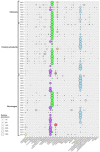Microbial Communities of Artisanal Fermented Milk Products from Russia
- PMID: 36363732
- PMCID: PMC9697859
- DOI: 10.3390/microorganisms10112140
Microbial Communities of Artisanal Fermented Milk Products from Russia
Abstract
Fermented milk products (FMPs) have numerous health properties, making them an important part of our nutrient budget. Based on traditions, history and geography, there are different preferences and recipes for FMP preparation in distinct regions of the world and Russia in particular. A number of dairy products, both widely occurring and region-specific, were sampled in the households and local markets of the Caucasus republics, Buryatia, Altai, and the Far East and European regions of Russia. The examined FMPs were produced from cow, camel, mare’s or mixed milk, in the traditional way, without adding commercial starter cultures. Lactate and acetate were the major volatile fatty acids (VFA) of the studied FMPs, while succinate, formate, propionate and n-butyrate were present in lower concentrations. Bacterial communities analyzed by 16S rRNA gene V4 fragment amplicon sequencing showed that Firmicutes (Lactococcus, Lactobacillus, Streptococcus, Lentilactobacillus and Leuconostoc) was the predominant phylum in all analyzed FMPs, followed by Proteobacteria (Acetobacter, Klebsiella, Pseudomonas and Citrobacter). Lactobacillus (mainly in beverages) or Lactococcus (mainly in creamy and solid products) were the most abundant community-forming genera in FMPs where raw milk was used and fermentation took place at (or below) room temperature. In turn, representatives of Streptococcus genus dominated the FMPs made from melted or pasteurized milk and fermented at elevated temperatures (such as ryazhenka, cottage cheese and matsoni-like products). It was revealed that the microbial diversity of koumiss, shubat, ryazhenka, matsoni-like products, chegen, sour cream and bryndza varied slightly within each type and correlated well with the same products from other regions and countries. On the other hand, the microbiomes of kefir, prostokvasha, ayran, cottage cheese and suluguni-like cheese were more variable and were shaped by the influence of particular factors linked with regional differences and traditions expressed in specificities in the production process. The microbial diversity of aarts, khurunga, khuruud, tan, ayran and suluguni-like cheese was studied here, to our knowledge, for the first time. The results of this study emphasize the overall similarity of the microbial communities of various FMPs on the one hand, and specificities of regional products on the other. The latter are of particular value in the age of globalization when people have begun searching for new and unusual products and properties. Speaking more specifically, these novel products, with their characteristic communities, might be used for the development of novel microbial associations (i.e., starters) to produce novel products with improved or unique properties.
Keywords: NGS; fermented beverages; fermented milk products; lactic acid bacteria; microbial community; traditional dairy products.
Conflict of interest statement
The authors declare no conflict of interest. The funders had no role in the design of the study; in the collection, analyses, or interpretation of data; in the writing of the manuscript, or in the decision to publish the result.
Figures






References
-
- Kandasamy S., Kavitake D., Shetty P.H. Innovations in Technologies for Fermented Food and Beverage Industries. Springer International Publishing; Cham, Switzerland: 2018. Lactic acid bacteria and yeasts as starter cultures for fermented foods and their role in commercialization of fermented foods; pp. 25–52.
-
- Pokhlebkin V.V. The Ethnic Cuisines of Our Peoples. Centrpoligraph; Moscow, Russia: 2004. p. 639.
-
- Teuber M. The Genera of Lactic Acid Bacteria. Springer US; Boston, MA, USA: 1995. The genus Lactococcus; pp. 173–234.
-
- de Melo Pereira G.V., de Carvalho Neto D.P., Maske B.L., De Dea Lindner J., Vale A.S., Favero G.R., Viesser J., de Carvalho J.C., Góes-Neto A., Soccol C.R. An updated review on bacterial community composition of traditional fermented milk products: What next-generation sequencing has revealed so far? Crit. Rev. Food Sci. Nutr. 2022;62:1870–1889. doi: 10.1080/10408398.2020.1848787. - DOI - PubMed
LinkOut - more resources
Full Text Sources

